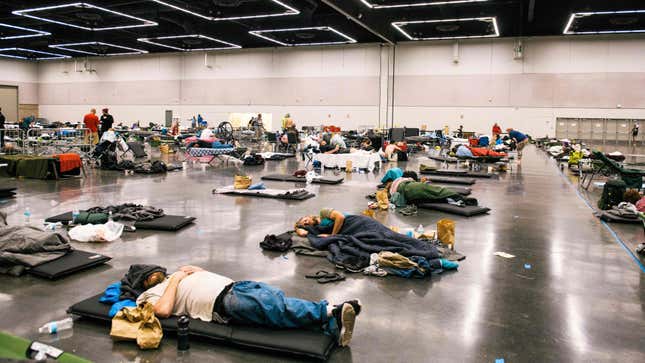
The record-breaking heat wave that’s blanketed the Pacific Northwest this week has quietly killed dozens across the region. Not everyone is affected equally, though. A disproportionate number of the elderly, the poor, and the alone have died of heat-related illnesses.
Temperatures in Canada have broken national records this week. On Tuesday, the small village of Lytton reached 121.2 degrees Fahrenheit (49.6 degrees Celsius), topping the all-time hottest temperatures Las Vegas. Unlike Vegas, though, air conditioning is not ubiquitous in the region, and it’s led to an escalating public health disaster we’re only now beginning to get a handle on.
At least 486 have died suddenly in British Columbia since Friday amid the unprecedented heat. That’s almost 200% more deaths than would have occurred in the same period in the average year, and the chief coroner said that “this number will increase as data continues to be updated.”
“The vast majority of these cases are related to the heat,” Vancouver sergeant Steve Addison said in a statement. “We’ve never seen anything like this, and it breaks our hearts.”
Meanwhile, in Oregon, which has also seen record-shattering heat this week, the state medical examiner’s office has attributed 63 deaths to heat-related causes so far. In the Portland area, officials recorded 97 visits to the emergency room and urgent care visits for heat illness, which is nearly the same number of cases they would see all summer. Washington state also reported that more than 1,300 people were rushed into emergency rooms this week due to heat exhaustion, dehydration, dizziness, or loss of consciousness. The state health department attributed at least three deaths to the heat, a number that could also rise.
Sustained triple-digit temperatures are dangerous for anyone, especially when the heat persists at night since the lack of crucial relief after sundown can make residents all the more vulnerable to heat stress, heatstroke, and other conditions. But though no one can withstand these temperatures for too long, not everyone is equally at risk during heat waves. Among the most vulnerable are the elderly; on Wednesday, Vancouver Police said that 70% of the victims they found were age 70 or older.
It’s well-documented that elderly people are more vulnerable to hypothermia, the umbrella term for heat-related illnesses that includes heatstroke, heat edema (which causes fluid to accumulate in the legs and feet), heat syncope (which causes sudden dizziness after exertion in high temperatures), and heat exhaustion. Part of what makes older people vulnerable to heat-related deaths is biological. As we age, we lose our ability to sweat and our ability to keep cool.
Seniors are also more likely to have underlying conditions that can be exacerbated by heat waves like cardiac and respiratory disease. Indeed, in Oregon’s Multnomah County, which includes most of Portland, the medical examiner said most who died had underlying health conditions.
But age is just one factor in determining someone’s risk in the face of extreme heat. Economic and cultural conditions can make or break people’s ability to survive. Those with people around them to keep tabs on their wellbeing tend to fare better. Studies of the deadly 1995 Chicago heat wave describe social isolation as an indicator of mortality. This dynamic seems to have played out beneath the heat dome over the West this week as well. Multnomah County’s medical examiner said that “many of those who died were found alone.”
As ever, access to money and resources can also save lives when temperatures get life-threatening. A likely reason that this week’s heat wave in the Northwest was so devastating is because many don’t have air conditioners. But even in regions where cooling technology is more common, heat can be a killer when people can’t afford to run it.
Poorer people, especially those of color, are also more likely to live in parts of cities with the most intense heat island effect owing to lack of trees and more uninterrupted asphalt. Those paved surfaces can radiate excess heat, leaving nearby areas 2 to 8 degrees Fahrenheit (1.1 to 4.4 degrees Celsius) hotter than their surrounding environments. Over the weekend, Oregon outreach workers said that two people who died in the town of Bend perished in a camp for people experiencing homelessness that had no shade.
The climate crisis will worsen these conditions, pushing temperatures higher. If cities don’t find ways to keep everyone cool, it could spell disaster. A 2020 study found that by 2100, extreme heat’s death toll will surpass the toll of all infectious diseases combined.
In a 2019 paper, Columbia legal scholar Michael Gerrard outlined legal tools that municipalities have to protect residents from dangerous heat. Among them are mandating frequent checks at nursing homes and assisted living facilities during heat waves and using low-income energy assistance programs to fund the purchase of air conditioners and covering the costs of running them when the mercury climbs.